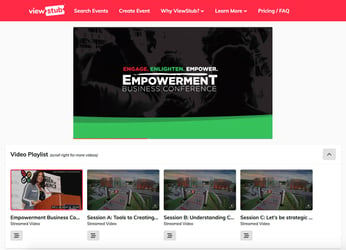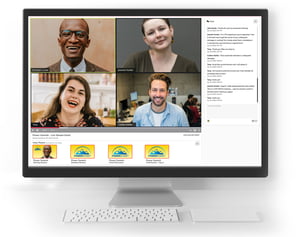 When you really think about it, virtual events are not all that different from in-person events. Remote attendees as well as in-person attendees are all consuming the same content, just in different ways. However, hosting a virtual event presents the added challenge of engaging the virtual audience in the experience of the live event.
When you really think about it, virtual events are not all that different from in-person events. Remote attendees as well as in-person attendees are all consuming the same content, just in different ways. However, hosting a virtual event presents the added challenge of engaging the virtual audience in the experience of the live event.
Planning virtual events requires much of the same thought process. There is a lot that goes into planning an event between developing topics, content creation, creating the agenda, and finalizing presentations the list goes on. Additionally, there are onsite logistics such as A/V, registration, catering, workshop activities, and entertainment. All these things have to be done whether the event is in-person, virtual or hybrid.
The biggest difference with virtual events is the attendee experience. Just like in-person events, organizers need to plan for how these remote attendees will participate in the event. What is their arrival experience like? Are they just dropped into the first session as it begins, or will there be an introduction to warm them up for the day’s events? How can you increase attendee interaction? It’s the small details that can make or break the virtual attendee experience.
If you’re feeling overwhelmed, relax. Our team has created a list of the top 7 ways to create engaging virtual events.
1. Live Stream your event
 Live streaming your event allows attendees to experience the event as it is occurring - just as if they event was in person! Live streaming drives just as much anticipation and excitement in a virtual environment as it would at in-person event. Additionally, live streaming adds a sense of exclusivity to an event. Organizers can provide exclusive-access to content like a product launch, sporting event or live music concerts. Instead of learning about a new product on social media after the event has occurred, attendees can be there as it is unveiled, in real-time. Live streaming is the perfect option for audiences who are unable to travel to the location, if the venue is at full capacity, or if health issues arise. Streaming the event ensures no person is left out of an event they wish to attend.
Live streaming your event allows attendees to experience the event as it is occurring - just as if they event was in person! Live streaming drives just as much anticipation and excitement in a virtual environment as it would at in-person event. Additionally, live streaming adds a sense of exclusivity to an event. Organizers can provide exclusive-access to content like a product launch, sporting event or live music concerts. Instead of learning about a new product on social media after the event has occurred, attendees can be there as it is unveiled, in real-time. Live streaming is the perfect option for audiences who are unable to travel to the location, if the venue is at full capacity, or if health issues arise. Streaming the event ensures no person is left out of an event they wish to attend.
Tip: When researching virtual platforms for your live stream event, look for technology that offers native streaming. Native streaming capabilities have been known to reduce compatibility issues and stream key conflicts that can affect stream quality and interruptions. You want the assurance of a reliable solution for live events.
2. Create a Monthly Series (or weekly)
Creating a series of events gives organizers more ways to engage with their audience. Recurring events build anticipation which can lead to social sharing and word-of-mouth growth. Social growth creates a community among audience members. People gravitate towards those who share the same interests, by creating a series, audience members have the ability to make lasting connections with their peers. Additionally, a series allows the host to isolate specific content and delve deep into each topic in various segments - producing more quality information for the attendees. Consider a white label video player to use these events to boost your brand.
Tip: Make sure your virtual platform offers the ability to sell a member pass or multi-session ticket for your event series.
3. Offer On-Demand Content
 Make your content available to view when it’s convenient for your attendees! Create a digital library of content and provide replay access to the knowledge discussed at the event. Additionally, this is a great way to further monetize the event. Organizers can sell exclusive on-demand access to the event content to continue to engage their audience. Selling on-demand access to content grows awareness of the event and can help attract new audiences for future events.
Make your content available to view when it’s convenient for your attendees! Create a digital library of content and provide replay access to the knowledge discussed at the event. Additionally, this is a great way to further monetize the event. Organizers can sell exclusive on-demand access to the event content to continue to engage their audience. Selling on-demand access to content grows awareness of the event and can help attract new audiences for future events.
Tip: Offer sponsors the ability to showcase their business in on-demand content. Be sure to collect audience data to optimize market value. Sponsors will be more willing to purchase larger sponsorship packages if they are ensured their business will be showcased to their target audience.
4. Provide Networking Opportunities
Networking opportunities are typically high on the list of the benefits for attending in-person events. Even though the event has gone virtual, there are still ways to incorporate networking opportunities into your virtual event. You may also consider implementing break out rooms. The majority of in-person conferences implement breakout sessions allowing the attendees to discuss the topic at hand and develop a personal relationship. The same thing can be done virtually! Make sure you choose a virtual event platform that allows you to seamlessly place attendees into breakout rooms.
Tip: Breakout sessions allow you to address a variety of topics to a targeted audience. Consider recording these sessions and offering playback of these sessions on your website for attendees to explore at their convenience.
5. Incorporate multiple ways to Interact
A primary reason people choose to attend events it to interact with others in their field or to connect with people who share common interests. Give the audience the ability to interact with you and others by adding various opportunities to provide feedback. For example: Give your remote audience a voice. Send out a poll asking attendees which session they found the most helpful or interesting. Deliver the results in real time during the event. You may also present the audience with a comical yet informative pop quiz to test and poke fun at their prior knowledge.
6. Up-sell premium experiences
 Create supplemental purchase options for your attendees to add to their virtual event experience and charge a premium for access to them. VIP experiences that you can easily add to your hybrid event and promote the exclusive access to them. Be sure to identify opportunities that your attendees would find valuable.
Create supplemental purchase options for your attendees to add to their virtual event experience and charge a premium for access to them. VIP experiences that you can easily add to your hybrid event and promote the exclusive access to them. Be sure to identify opportunities that your attendees would find valuable.
Here are some basic ideas to consider:
- Workshops with industry experts
- Q&A session with a key speaker
- Sell raffle tickets to a meet & greet with a celebrity
|
Recommended Read: Top 5 Ways to Monetize Virtual Events – Event organizers are searching for new ways to make a profit from their events. Check out our list of the top 5 ways to make money from virtual events.

|
7. Host a panel discussion
A panel discussion is a great way to allow the audience to hear from different points of views on a topic. Viewers can gain multiple perspectives and truly discover the pros and cons around the topic. Additionally, choose a platform in which audience members are able to join the panel live, on screen with questions about the topic. The audience can further engage themselves in the event delivering more value in the knowledge they gained by attending the event.
Tip: Make sure to choose a virtual event platform that highlights the person speaking so the audience can see exactly who is speaking.
In this new era, it is essential that virtual events engage audience members in a way that adds value comparable to attending an in-person event. With a bit of creativity and knowledge, there is no reason for remote attendees to feel left out of an event. Although the event may be virtual you have the ability to make its impact on attendees just as meaningful.

 When you really think about it, virtual events are not all that different from in-person events. Remote attendees as well as in-person attendees are all consuming the same content, just in different ways. However, hosting a virtual event presents the added challenge of engaging the virtual audience in the experience of the live event.
When you really think about it, virtual events are not all that different from in-person events. Remote attendees as well as in-person attendees are all consuming the same content, just in different ways. However, hosting a virtual event presents the added challenge of engaging the virtual audience in the experience of the live event.

 Make your content available to view when it’s convenient for your attendees! Create a digital library of content and provide replay access to the knowledge discussed at the event. Additionally, this is a great way to further
Make your content available to view when it’s convenient for your attendees! Create a digital library of content and provide replay access to the knowledge discussed at the event. Additionally, this is a great way to further 
 Create supplemental purchase options for your attendees to add to their virtual event experience and charge a premium for access to them. VIP experiences that you can easily add to your hybrid event and promote the exclusive access to them. Be sure to identify opportunities that your attendees would find valuable.
Create supplemental purchase options for your attendees to add to their virtual event experience and charge a premium for access to them. VIP experiences that you can easily add to your hybrid event and promote the exclusive access to them. Be sure to identify opportunities that your attendees would find valuable.
